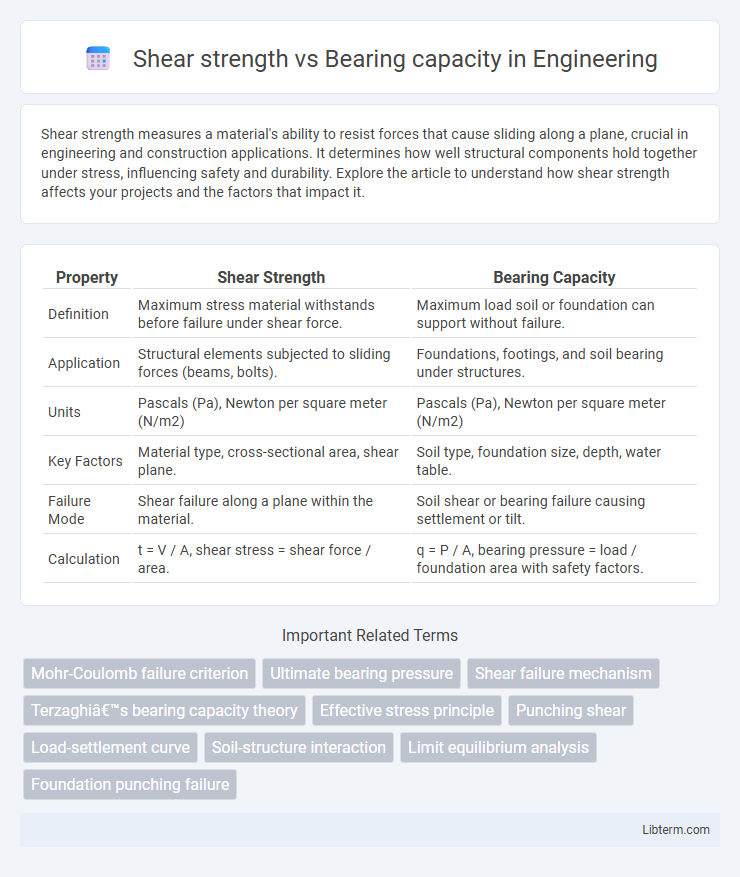Shear strength measures a material's ability to resist forces that cause sliding along a plane, crucial in engineering and construction applications. It determines how well structural components hold together under stress, influencing safety and durability. Explore the article to understand how shear strength affects your projects and the factors that impact it.
Table of Comparison
| Property | Shear Strength | Bearing Capacity |
|---|---|---|
| Definition | Maximum stress material withstands before failure under shear force. | Maximum load soil or foundation can support without failure. |
| Application | Structural elements subjected to sliding forces (beams, bolts). | Foundations, footings, and soil bearing under structures. |
| Units | Pascals (Pa), Newton per square meter (N/m2) | Pascals (Pa), Newton per square meter (N/m2) |
| Key Factors | Material type, cross-sectional area, shear plane. | Soil type, foundation size, depth, water table. |
| Failure Mode | Shear failure along a plane within the material. | Soil shear or bearing failure causing settlement or tilt. |
| Calculation | t = V / A, shear stress = shear force / area. | q = P / A, bearing pressure = load / foundation area with safety factors. |
Introduction to Shear Strength and Bearing Capacity
Shear strength refers to the maximum resistance of a material or soil to forces that cause sliding along a plane, crucial in preventing structural failure. Bearing capacity is the ability of soil to support loads applied to the ground, determined by factors such as soil type, depth, and load distribution. Understanding the relationship between shear strength and bearing capacity is essential for designing safe foundations and geotechnical structures.
Definitions: Shear Strength Explained
Shear strength refers to the maximum stress a material can withstand before failure occurs due to sliding or shearing forces along a plane, crucial in soil mechanics and structural engineering. Bearing capacity is the ability of soil or material to support loads applied to the ground without experiencing shear failure or excessive settlement. Understanding shear strength is essential for assessing slope stability, foundation design, and preventing structural failures by determining resistance against shear-induced deformations.
Understanding Bearing Capacity in Geotechnical Engineering
Bearing capacity in geotechnical engineering refers to the maximum load per unit area that soil can support without experiencing shear failure or excessive settlement. It is a critical parameter for designing foundations, ensuring stability by accounting for soil properties such as cohesion, friction angle, and density. Accurate evaluation of bearing capacity involves empirical, analytical, and numerical methods to assess soil shear strength parameters and stress distribution beneath foundations.
Key Differences Between Shear Strength and Bearing Capacity
Shear strength refers to the maximum stress a material can withstand parallel to its surface without failure, primarily related to soil or structural materials resisting sliding forces. Bearing capacity is the maximum load a foundation soil can support vertically without experiencing shear failure or excessive settlement. The key difference lies in shear strength focusing on shear stress resistance within a material, while bearing capacity concerns the soil's ability to support structural loads without collapsing.
Factors Influencing Shear Strength of Soils
Shear strength of soils is primarily influenced by factors such as soil texture, moisture content, density, and confining pressure, which determine the soil's internal friction and cohesion. Particle arrangement and type, effective stress, and the presence of water also play critical roles in modifying shear resistance. Unlike bearing capacity, which depends on the soil's ability to support loads without excessive settlement, shear strength specifically governs the soil's resistance to shear deformation and failure.
Determinants Affecting Bearing Capacity
Bearing capacity is primarily influenced by soil type, depth and width of the foundation, and groundwater conditions, which affect its ability to support loads without excessive settlement or failure. Shear strength, determined by cohesion and internal friction angle of the soil, directly impacts bearing capacity by governing the soil's resistance to shear stress under the foundation. Other critical determinants include soil density, layer stratification, and presence of discontinuities or weak zones within the soil mass.
Laboratory and Field Testing Methods
Shear strength and bearing capacity are critical parameters in geotechnical engineering assessed through various laboratory and field testing methods. Laboratory tests such as direct shear, triaxial compression, and unconfined compression provide controlled environments to measure soil shear strength accurately. Field tests, including standard penetration test (SPT), cone penetration test (CPT), and plate load test, offer in-situ data on bearing capacity and shear strength, reflecting real ground conditions.
Practical Applications in Civil Engineering Design
Shear strength and bearing capacity are critical parameters in civil engineering design, directly influencing the stability and safety of structures such as foundations, retaining walls, and slopes. Shear strength determines a soil or material's ability to resist internal sliding failure, essential for designing retaining structures and slope stabilization. Bearing capacity assesses the maximum load soil can support beneath foundations without failure, guiding the sizing and depth of footings to prevent settlement or collapse.
Common Failures: Shear vs. Bearing Capacity
Shear strength failure occurs when the soil or material slides along a failure plane due to insufficient internal cohesion, often resulting in a sudden collapse. Bearing capacity failure happens when the soil beneath a foundation cannot support the applied load, causing excessive settlement or tilting, which compromises structural stability. Common shear failures include slope instability and soil slippage, while bearing capacity failures manifest as foundation sinking or differential settlement affecting building integrity.
Conclusion: Selecting the Right Parameter for Foundation Design
Shear strength and bearing capacity are critical parameters in foundation design that govern soil stability and load-bearing performance. Shear strength determines soil resistance to failure along potential slip surfaces, while bearing capacity defines the maximum load the soil can support without excessive settlement or collapse. Selecting the right parameter depends on site conditions and load types, with bearing capacity prioritized for overall foundation stability and shear strength crucial for assessing slope and lateral stability.
Shear strength Infographic

 libterm.com
libterm.com